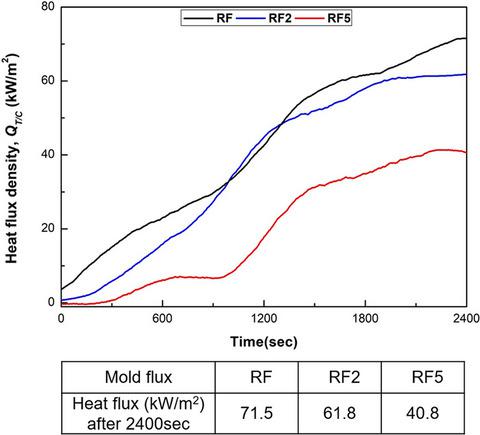当前位置:
X-MOL 学术
›
J. Am. Ceram. Soc.
›
论文详情
Our official English website, www.x-mol.net, welcomes your
feedback! (Note: you will need to create a separate account there.)
Heat transfer control by dispersed metallic particles in glassy mold flux film for continuous steel casting
Journal of the American Ceramic Society ( IF 3.5 ) Pub Date : 2020-06-08 , DOI: 10.1111/jace.17294 Sung‐Hee Hyun 1 , Jung‐Wook Cho 1
Journal of the American Ceramic Society ( IF 3.5 ) Pub Date : 2020-06-08 , DOI: 10.1111/jace.17294 Sung‐Hee Hyun 1 , Jung‐Wook Cho 1
Affiliation

|
To assess the effect of metallic particles (MPs) on heat transfer in glassy mold flux, a structurally stable glassy mold flux system composed of CaO–Al2O3–CaF2 was examined with 0, 2, or 5 wt% of FeO or Fe MPs. The change of extinction coefficient by Mie Scattering of the Fe particles and absorption by FeO was quantified using Fourier transformation infrared ray spectroscopy and an Ultraviolet/Visible spectrometry. Thermal conductivity of mold flux film with dispersed MPs was quantified using laser flash technique. One‐dimensional Debye temperature was calculated, and particle morphology and size distribution were observed using image analysis to explain variations in thermal conductivity among the glass samples. Finally, to simulate the heat transfer ratio by both the conduction and radiation, the actual heat flux through mold flux film was measured using an Infrared Emitter Technique. The overall heat transfer rate across liquid flux film could be reduced significantly by a dispersion of MPs.
中文翻译:

连续铸钢中玻璃态熔剂膜中分散的金属颗粒对传热的控制
为了评估金属颗粒(MPs)对玻璃状助熔剂传热的影响,使用了由CaO–Al 2 O 3 –CaF 2组成的结构稳定的玻璃状助熔剂系统。用0、2或5 wt%的FeO或Fe MP进行检测。使用傅立叶变换红外光谱法和紫外/可见光谱法定量分析Fe颗粒的米氏散射引起的消光系数变化和FeO的吸收。使用激光闪光技术对具有分散的MP的保护渣膜的热导率进行了定量。计算一维德拜温度,并使用图像分析观察颗粒形态和尺寸分布,以解释玻璃样品之间的热导率变化。最后,为了通过传导和辐射来模拟传热比,使用红外发射器技术测量了通过铸模助熔剂膜的实际热通量。通过分散MP可以显着降低液体通量薄膜上的总传热速率。
更新日期:2020-08-10
中文翻译:

连续铸钢中玻璃态熔剂膜中分散的金属颗粒对传热的控制
为了评估金属颗粒(MPs)对玻璃状助熔剂传热的影响,使用了由CaO–Al 2 O 3 –CaF 2组成的结构稳定的玻璃状助熔剂系统。用0、2或5 wt%的FeO或Fe MP进行检测。使用傅立叶变换红外光谱法和紫外/可见光谱法定量分析Fe颗粒的米氏散射引起的消光系数变化和FeO的吸收。使用激光闪光技术对具有分散的MP的保护渣膜的热导率进行了定量。计算一维德拜温度,并使用图像分析观察颗粒形态和尺寸分布,以解释玻璃样品之间的热导率变化。最后,为了通过传导和辐射来模拟传热比,使用红外发射器技术测量了通过铸模助熔剂膜的实际热通量。通过分散MP可以显着降低液体通量薄膜上的总传热速率。











































 京公网安备 11010802027423号
京公网安备 11010802027423号